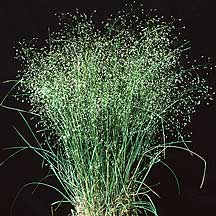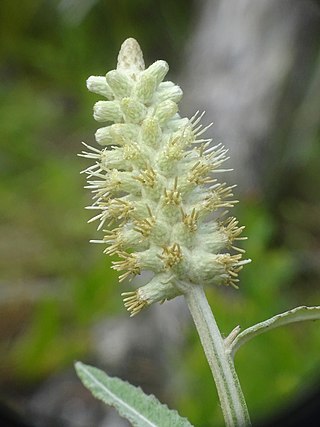
André Michaux, also styled Andrew Michaud, was a French botanist and explorer. He is most noted for his study of North American flora. In addition Michaux collected specimens in England, Spain, France, and even Persia. His work was part of a larger European effort to gather knowledge about the natural world. Michaux's contributions include Histoire des chênes de l'Amérique and Flora Boreali-Americana which continued to be botanical references well into the 19th century. His son, François André Michaux, also became an authoritative botanist.

Arundinaria is a genus of bamboo in the grass family the members of which are referred to generally as cane. Arundinaria is the only bamboo native to North America, with a native range from Maryland south to Florida and west to the southern Ohio Valley and Texas. Within this region Arundinaria canes are found from the Coastal Plain to medium elevations in the Appalachian Mountains.

Oryzopsis is a genus of Chinese and North American plants in the grass family. Species from this genus are commonly called ricegrass.

Cardamine concatenata, the cutleaved toothwort, crow's toes, pepper root or purple-flowered toothwort, is a flowering plant in the family Brassicaceae. It is a perennial woodland wildflower native to eastern North America.

Cardamine diphylla is a flowering plant in the family Brassicaceae. It is a spring flowering woodland plant that is native to eastern North America.

Diphylleia is a group of large herbs in the family Berberidaceae described as a genus in 1803. It is native to the eastern United States and eastern Asia.

Phyllospadix, commonly known as surfgrass, is a genus of seagrass, a flowering plant in the family Zosteraceae, described as a genus in 1840. Phyllospadix grows in marine waters along the coasts of the temperate North Pacific.

Bolboschoenus robustus is a species of flowering plant in the sedge family. It is known by many common names: saltmarsh bulrush, alkali bulrush, sturdy bulrush, seacoast bulrush, stout bulrush, three-cornered sedge or leafy three-cornered sedge, and seaside club-rush.

Tofieldia is a small genus of flowering plants described as a genus in 1778. It is widespread across much of Europe, Asia, and North America.

Triantha is a small genus of flowering plants in the family Tofieldiaceae, first described as a genus in 1879. False asphodel is a common name for plants in this genus.

Pterocaulon pycnostachyum, with the common names dense-spike blackroot, fox-tail blackroot or coastal blackroot, is a plant species native to Alabama, Mississippi, North Carolina, Florida, Georgia, and South Carolina. It can be found in pinelands, ditches, depressions, and fields.
Lysimachia hybrida, common name Mississippi loosestrife or lowland yellow loosestrife, is a plant species widespread in much of the United States and Canada, absent only from the deserts in the west and the Arctic and sub-Arctic regions of the far north. It prefers moist locales such as marshes, swamps, wet meadows, stream banks, etc.

Leavenworthia uniflora, called Michaux's gladecress or one-flowered gladecress, is a plant species native to the southeastern and Midwestern parts of the United States. It is reported from northwestern Georgia, northern Alabama, Tennessee, northern Arkansas, southern Missouri, Kentucky, southeastern Indiana, southwestern Ohio, and northwestern Virginia. It grows in open, sun-lit locations at elevations less than 500 meters.

Rhododendron flammeum, the Piedmont azalea or Oconee azalea, is a plant species native to the US states of Georgia and South Carolina. It is found in dry woods and stream bluffs at elevations less than 500 m. The common name is taken from Oconee County, South Carolina.

Lyonia fruticosa, the poor-grub or coastal plain staggerbush, is a plant species native to the US states of Florida, southern Georgia and the extreme southern part of South Carolina. It grows in pine woodlands and shrub bogs at elevations less than 100 meters.

Sagittaria graminea, the grassy arrowhead or grass-leaved arrowhead, is an aquatic plant species native to eastern North America.

Houstonia serpyllifolia, commonly called thymeleaf bluet, creeping bluet, mountain bluet, Appalachian bluet or Michaux's bluets is a species of plant in the coffee family (Rubiaceae). It is native to the eastern United States, where it is found in the central and southern Appalachian Mountains. It has been documented in the states of Pennsylvania, Maryland, West Virginia, western Virginia, North Carolina, South Carolina, Kentucky, Tennessee, Ohio, and northeastern Georgia.

Galium latifolium is a North American species of plants in the madder family. It is native to eastern North America, primarily the Appalachian Mountains from Pennsylvania to Alabama. There are also a few lowland populations in eastern Maryland and eastern South Carolina.
Galium uniflorum, common name oneflower bedstraw, is a species of plants in the Rubiaceae. It is native to the southeastern United States from eastern Texas to Maryland.

Hypericum frondosum, the cedarglade St. Johnswort or golden St. John's wort, is a species of flowering plant in the St. John's wort family, Hypericaceae. It is native to the central and southeastern United States in dry, rocky habitats.


















